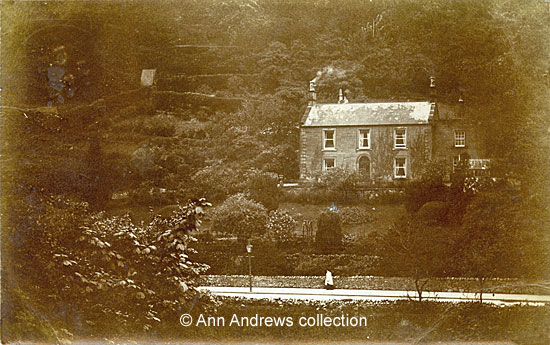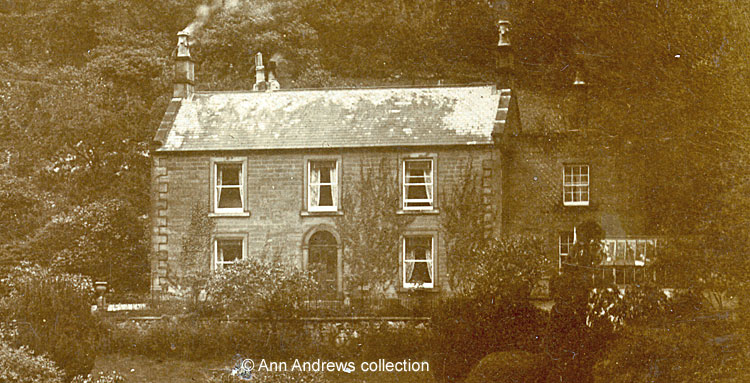|
Images Index> Matlock Dale> This page |
| Tor Hill House, Dale Road, Matlock Bath, 1915 |
| Matlock Dale: Twentieth Century Photographs, Postcards, Engravings & Etchings |
|
|
||||||||||||||
|
"TOR HOUSE is beautifully situated on rising ground in Matlock Dale, ... nearly opposite the time honoured HIGH TOR and the grounds adjoining, and on the acclivity above covering upwards of SIX ACRES, are mostly tastefully laid out with SHRUBBERIES, PARTERRES, RUSTIC SEATS, and SHADY GRAVEL WALKS ...[2]." William Adam also commented that "Robinson's lodging house is beautifully situated, and has excellent walks and a good garden connected with it[3]." When Thomas Robinson died at Tor House in December 1856, aged 78, his obituary noted that the "deceased had been nearly 40 years an inhabitant of Matlock, and had never made an enemy. His loss is deplored by all who knew him[4]." His home was then tenanted by Col. Leacroft, who passed away in 1962[5].
Mr. Stevens, who was involved with the colour works across the road, became the next owner[7]. In 1882 several announcements by Messrs. Else of Matlock advertised the house and land for sale, again without mentioning a quarry on the property[8]. However, earlier that year Matlock Bath's Local Board had written to Mr. Stevens about repairing the damage to the footpath near his quarry, caused by carts running over it[9]: the quarry was already shown on a contemporary OS map[10]. As Mr. Stevens died at Matlock on 12 June 1882, perhaps the omission of the quarry in the sale notices was an oversight. His family did not sell the house at that time. A sad incident was reported in early July the same year when a young man from Wolverhampton, aged about 20, descended from the Heights of Abraham to the top of Mr. Stevens' stone quarry on Matlock Dale. "He endeavoured by means of an iron chain to descend the quarry, and had arrived at nearly the length of the chain when he lost his hold and fell down the rocks for about forty feet." The unfortunate young man broke one leg and severely strained his ankle[11]. Twelve years later Tor House and its grounds were again on the market. Valuable Freehold residence, with Pleasure Grounds and Gardens, Stables, Coach House, Cottages, and Limestone Quarry. To be sold by auction Tor House, two dwelling houses and the stone quarry, "in the most picturesque part of the valley" were bought by Miss Pearson of Brunswood House for £1,900[13]. Eliza Pearson was one of the daughters of James Pearson and his wife Sarah, nee Palmer. Amongst her brothers was David Palmer Pearson, a Matlock Bath antiquarian. The first thing she did was to change the name to Tor Hill House, possibly because Tor Cottage, later the High Tor Hotel, had also become known as Tor House.
She also redecorated and the following year advertised the house To Let[14]. Two pairs of semi-detached houses, known
as Hazel Bank, were then built in the quarry between the stable/coach house building and Mrs. Whittaker's bottling plant. Not long afterwards, a local paper
commented that "If the proprietors of land in Matlock Dale continue to make pretty patches of their frontages, like the Misses Pearson and Mrs. Whittaker,
the promenade will soon be accomplished[15]." This was a reference to the plan by Charles Peters to turn
the riverbank on the opposite side of the road into a public promenade. When Eliza passed away in 1912 an obituary said that "horticulture was her hobby, and though over 60 years of age, she always superintended the laying out of her garden in front of her house[16]". She had lived here with her sister Miriam Jemima, known as Minnie, who remained at Tor Hill House until her death in 1938. She left Tor Hill House and two other dwellings to her nephew John Douglas Pearson King, with a proviso that her housekeeper should be able to use one of the houses for her lifetime[17]. Her estate administered by another nephew Dick Pearson King of Brunswood House.
It was feared that more of the cliff would come down and just before dawn the following morning a 160 ton giant boulder crashed down, landing what was initially thought to be just a very short distance from two more houses. It was later discovered to have smashed the back pantry and cracks had developed on the kitchen ceiling of 2 Hazel Bank. Skilled quarrymen from Derbyshire Stone Ltd. then inspected another massive rock which overhung the site. They drilled bore holes for explosives, which were designed to break up the rock as it fell. Photographs taken from the top of High Tor afterwards show an area behind the houses that resembled an avalanche, filled with the broken up stone. Both Matlock Council officials and the Trust were subsequently asked if the properties that remained could be re-occupied and both bodied responded that it was doubtful. In the end all the homes were demolished with just the stables and coach house of Tor Hill Cottages remaining, so nothing of the homes that had been above them survived[18]. They are still boarded up today and the former quarry site is covered with trees (2024). |
|||||||||||||||
1. and 2. Untitled [Tor Hill House, Matlock Dale]. No publisher. Posted 19 Sep 1915 in Matlock. Sent by Miss Minnie Pearson to her sister/relative Miss J Pearson who had been staying with her. "The weather is still lovely". 3. Advertisement published in "The Matlocks, Derbyshire"", published about 1950 and printed by Geo. Hodgkinson, Printer, Matlock. From the collection of, written, researched by and © Ann Andrews. Intended for personal use only. |
|||||||||||||||
References (coloured links are to more information elsewhere on this web site): [1] Thomas Robinson can be found on Matlock & Matlock Bath Public Notices &
Announcements, 1822. [2] "Derby Mercury", 18 and 25 May 1853. [3] Adam, W. (1857, 6th edtn.) "The Gem of the Peak; or Matlock Bath and Its Vicinity". ... John and Charles Mozley, Derby and 6, Paternoster Row, London; Bemrose .... (own copy). [4] "Derbyshire Advertiser and Journal", 19 December 1856. [5] "Derbyshire Advertiser and Journal", 28 November 1862. DEATHS. Leacroft - On Friday last, Tor House, near Matlock Bath, Colonel Leacroft, at an advanced age. See and Game Duty Lists, Gentlemen's and Gamekeepers' Certificates, 1800 - 1852 and 1861 census. He can also be found in the following trades directories for Matlock Bath: Kelly's 1855 | White's 1857 | White's 1862 | Kelly's 1864. [6] "Derby Mercury", 5 February 1868. [7] Thomas and Frederick Wm. Stevens were shown as barytes manufacturers in White's 1852 Directory. Frederick and some of his family had moved to Matlock before the 1851 census. [8] "Derbyshire Times", 10 June 1882. The advertisement appeared on several other dates that month. [9] "Derby Mercury", 11 January 1882. Matlock Bath. Local Board. This mentions the quarry. [10]The OS map of Derbyshire XXXIV.2, surveyed in 1876 and published in 1880 showed a quarry near the bottom of the drive of Tor House and its stable/coach house block. It was not part of Long Tor Quarry, although that quarry was not far away. [11] "Alfreton Journal", 7 Jul 1882. Matlock Bath. Accidents. [12] "Derbyshire Advertiser", 14 April 1894. The sale notice was also published in the "Derby Mercury" of 11 and 25 April 1894. [13] "Matlock Visiting List", 9 May 1894. [14] "Derbyshire Advertiser", 8 June 1895. [15] "Derbyshire Times", 18 April 1896. [16] "ibid.", 1 May 1912. Death of Miss E Pearson of Tor Hill House. Eliza was 63 years old. [17] "Derby Daily Telegraph", Miriam Pearson left several items to housekeeper Emily Ann Wetton, including the use of one of her houses (£50, pets, wearing apparel. and £1 for life). The following year Miss Wetton was living in one of the Hazel Bank houses. Sidney Greatorex, her gardener, received £10. [18] "Derbyshire Times", 14 January 1966. Prompt aid for landslip victims. Council rehouses stricken families. The disaster had happened on the Sunday 9th January (this was one of two lengthy articles published in the DT). More has been extracted from an article by Tony Brooks that was published in an unnamed newspaper, probably the "Daily Express". These have been provided by Grenville Smith. |






